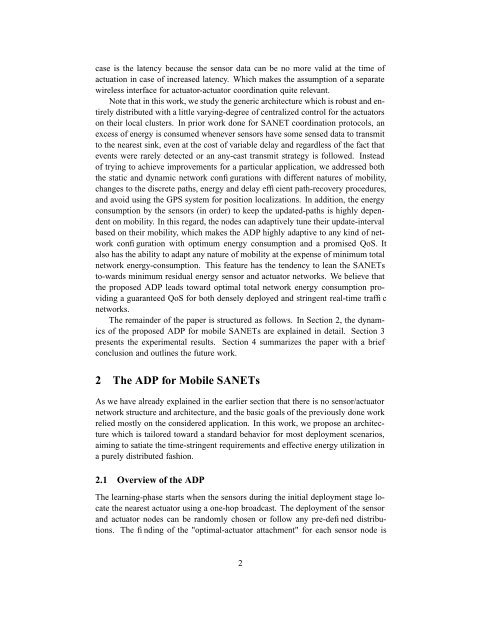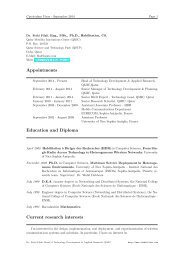Performance Analysis of the Actuator Discovery Protocol ... - Fethi Filali
Performance Analysis of the Actuator Discovery Protocol ... - Fethi Filali
Performance Analysis of the Actuator Discovery Protocol ... - Fethi Filali
Create successful ePaper yourself
Turn your PDF publications into a flip-book with our unique Google optimized e-Paper software.
case is <strong>the</strong> latency because <strong>the</strong> sensor data can be no more valid at <strong>the</strong> time <strong>of</strong><br />
actuation in case <strong>of</strong> increased latency. Which makes <strong>the</strong> assumption <strong>of</strong> a separate<br />
wireless interface for actuator-actuator coordination quite relevant.<br />
Note that in this work, we study <strong>the</strong> generic architecture which is robust and entirely<br />
distributed with a little varying-degree <strong>of</strong> centralized control for <strong>the</strong> actuators<br />
on <strong>the</strong>ir local clusters. In prior work done for SANET coordination protocols, an<br />
excess <strong>of</strong> energy is consumed whenever sensors have some sensed data to transmit<br />
to <strong>the</strong> nearest sink, even at <strong>the</strong> cost <strong>of</strong> variable delay and regardless <strong>of</strong> <strong>the</strong> fact that<br />
events were rarely detected or an any-cast transmit strategy is followed. Instead<br />
<strong>of</strong> trying to achieve improvements for a particular application, we addressed both<br />
<strong>the</strong> static and dynamic network configurations with different natures <strong>of</strong> mobility,<br />
changes to <strong>the</strong> discrete paths, energy and delay efficient path-recovery procedures,<br />
and avoid using <strong>the</strong> GPS system for position localizations. In addition, <strong>the</strong> energy<br />
consumption by <strong>the</strong> sensors (in order) to keep <strong>the</strong> updated-paths is highly dependent<br />
on mobility. In this regard, <strong>the</strong> nodes can adaptively tune <strong>the</strong>ir update-interval<br />
based on <strong>the</strong>ir mobility, which makes <strong>the</strong> ADP highly adaptive to any kind <strong>of</strong> network<br />
configuration with optimum energy consumption and a promised QoS. It<br />
also has <strong>the</strong> ability to adapt any nature <strong>of</strong> mobility at <strong>the</strong> expense <strong>of</strong> minimum total<br />
network energy-consumption. This feature has <strong>the</strong> tendency to lean <strong>the</strong> SANETs<br />
to-wards minimum residual energy sensor and actuator networks. We believe that<br />
<strong>the</strong> proposed ADP leads toward optimal total network energy consumption providing<br />
a guaranteed QoS for both densely deployed and stringent real-time traffic<br />
networks.<br />
The remainder <strong>of</strong> <strong>the</strong> paper is structured as follows. In Section 2, <strong>the</strong> dynamics<br />
<strong>of</strong> <strong>the</strong> proposed ADP for mobile SANETs are explained in detail. Section 3<br />
presents <strong>the</strong> experimental results. Section 4 summarizes <strong>the</strong> paper with a brief<br />
conclusion and outlines <strong>the</strong> future work.<br />
2 The ADP for Mobile SANETs<br />
As we have already explained in <strong>the</strong> earlier section that <strong>the</strong>re is no sensor/actuator<br />
network structure and architecture, and <strong>the</strong> basic goals <strong>of</strong> <strong>the</strong> previously done work<br />
relied mostly on <strong>the</strong> considered application. In this work, we propose an architecture<br />
which is tailored toward a standard behavior for most deployment scenarios,<br />
aiming to satiate <strong>the</strong> time-stringent requirements and effective energy utilization in<br />
a purely distributed fashion.<br />
2.1 Overview <strong>of</strong> <strong>the</strong> ADP<br />
The learning-phase starts when <strong>the</strong> sensors during <strong>the</strong> initial deployment stage locate<br />
<strong>the</strong> nearest actuator using a one-hop broadcast. The deployment <strong>of</strong> <strong>the</strong> sensor<br />
and actuator nodes can be randomly chosen or follow any pre-defined distributions.<br />
The finding <strong>of</strong> <strong>the</strong> "optimal-actuator attachment" for each sensor node is<br />
2





